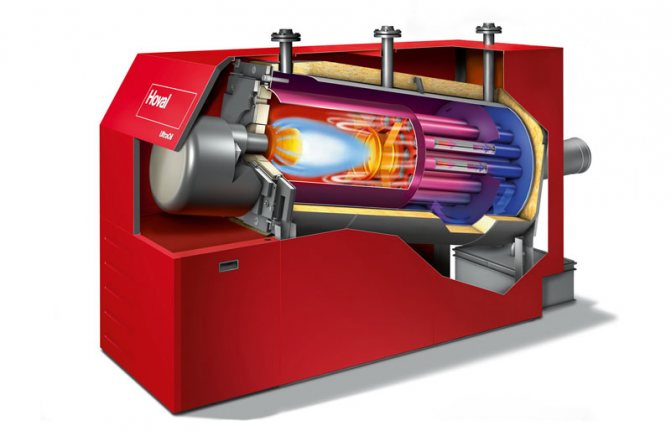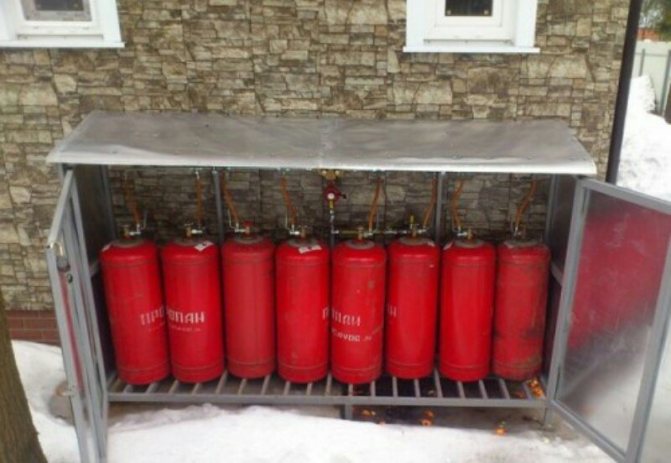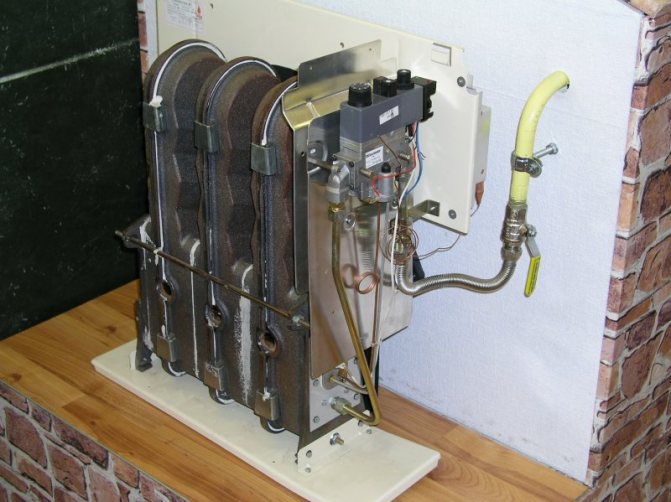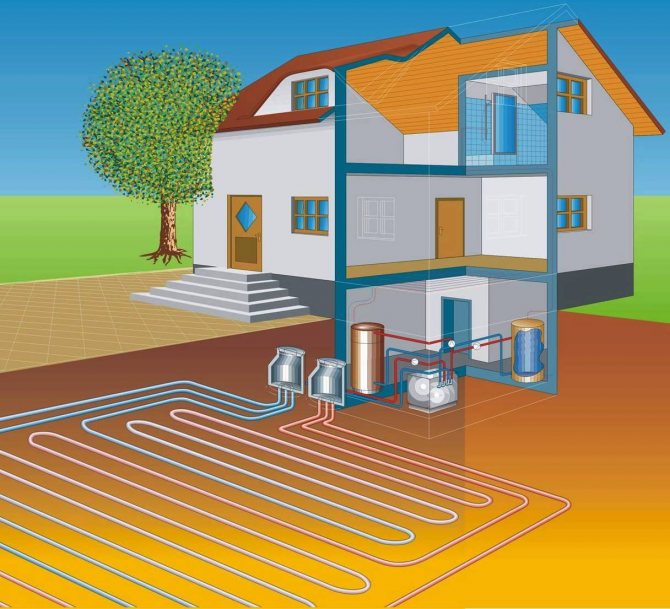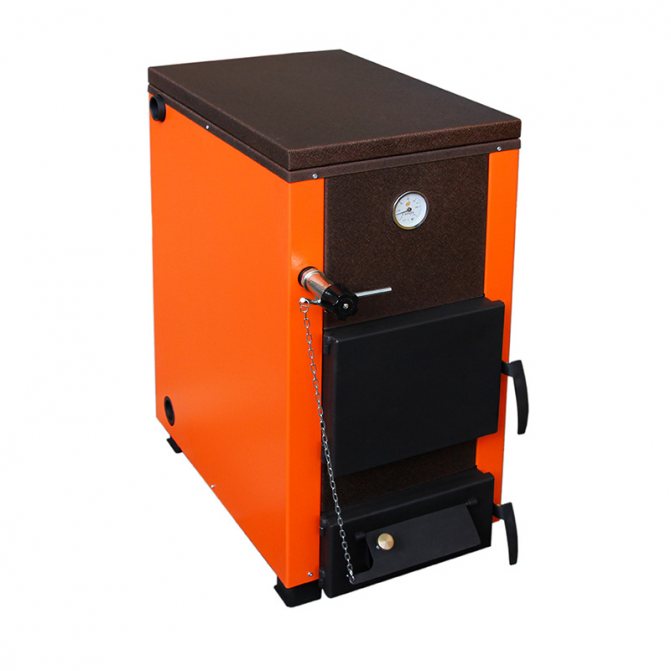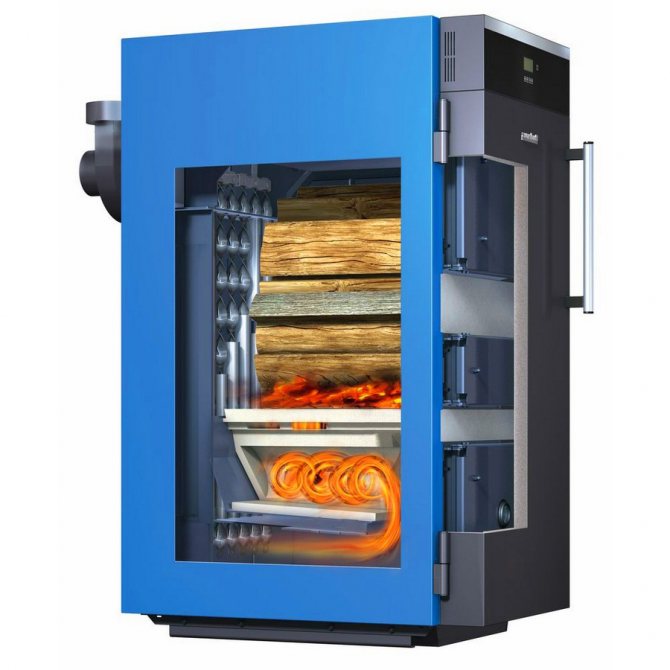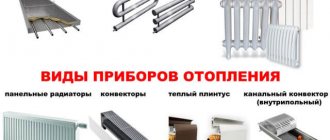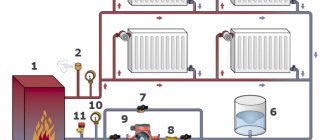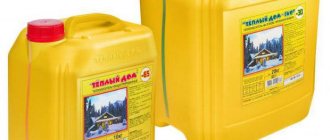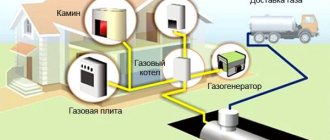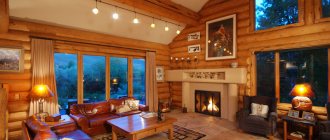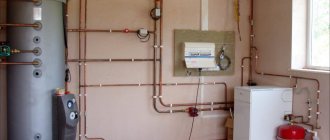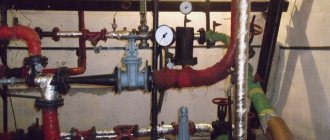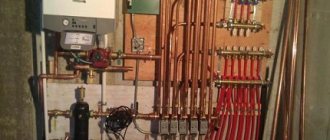Heat sources
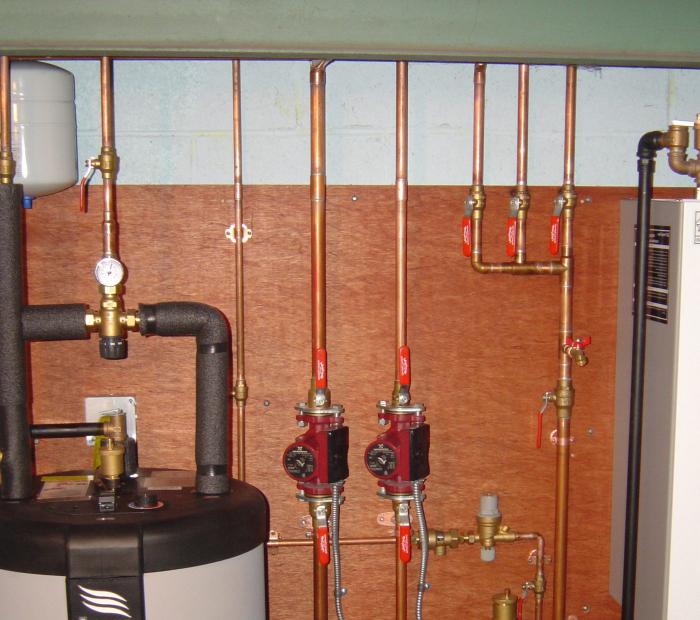
Despite the development of new modern options, standard methods are very popular. People prefer to receive and comply with the technical conditions prescribed by the gas supply company, install gas boilers, and connect to main pipelines. If the settlement where the house is located is not supplied with gas, then many people make electric heating or build a firewood stove. A more modern option is solid fuel boilers.
Also, those who are looking for options on how to arrange heating without gas and firewood pay attention to liquid fuel units. Diesel fuel is required for their work. In addition to diesel fuel, they run on rapeseed oil or kerosene. They can be steam or hot water.
Another option is pyrolysis boilers. The principle of their operation is based on the fact that the coolant is heated by steel heat exchangers, in which heating elements are mounted. This is one of the options for electric heating.
How cheap to heat your house
There are a great many options for heating units and systems. Most of them convert the energy of fuel combustion into thermal energy, contributing to the best circulation of warm air inside the building.
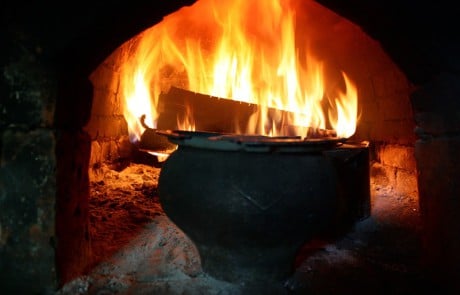

The warmth of the hearth
Heating types
Heating of apartments in high-rise buildings is most often central, although now many houses are switching to autonomous systems, which is considered much more beneficial in terms of quality and economics. In low-rise buildings, private country houses, in summer cottages, heating can be arranged:
- Also steam central,
- Autonomous gas or electric,
- Furnace using various types of fuel,
- Fireplace.
You can have both heating without pipes and communications, consisting of only one heating device, or a whole system with batteries and pipe lines.
The cheapest fuel
Heating devices can use various fuels - solid, liquid, gaseous, electronic. At the same time, its traditional types are not always more convenient or cheaper for the consumer:
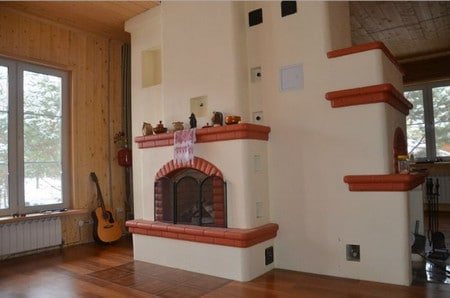

Stove complex with fireplace
- Electricity is the easiest way to organize heating, but also one of the most expensive.
- Gas heating is cheaper, but it should be borne in mind that main gas and liquefied gas are somewhat different things, since the basis of the gas supplied centrally is methane, and the substance in the cylinders is propane-butane, the combustion of which is 4-5 times more expensive;
- Diesel fuel - diesel fuel - is also quite an expensive pleasure (1 Gcal of heat will cost more than 3.5 thousand rubles), which creates an unpleasant smell near the heating apparatus, although it can become an affordable alternative to centrally supplied fuel types.
- Coal is a fairly cheap fuel, with which heating will cost 3-4 times cheaper than with diesel fuel (1 Gcal of heat will cost about 1 thousand rubles),
- Peat supplied in briquettes is about 1.5 times more expensive than coal,
- Firewood will cost quite cheaply, but here it is worth considering that it is not always convenient to use them, and they burn out much faster than coal,
- Pellets - granules based on wood waste - will give 1 Gcal for about 1.5 thousand rubles, while they are convenient to use for boilers where fuel is supplied automatically.
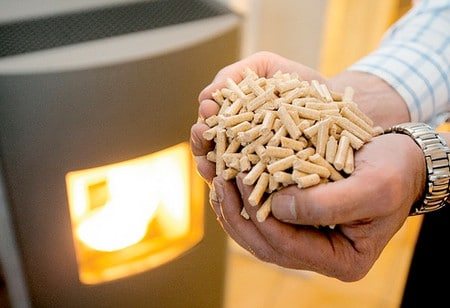

Pellets - an alternative fuel
Alternative models
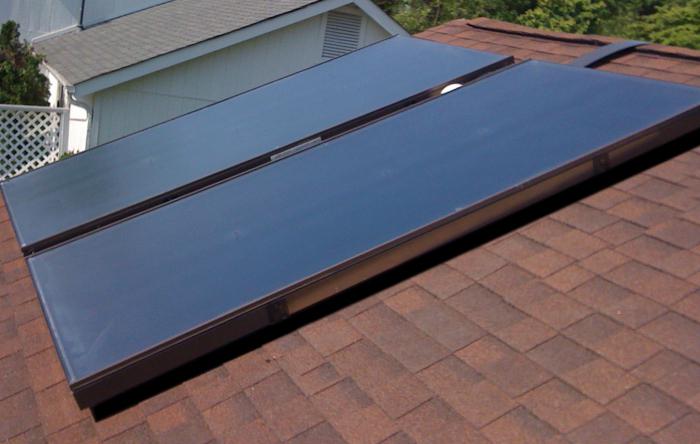

If you want to equip heating, but at the same time do not use standard universal gas-wood heating boilers, then you will be interested in newfangled alternative systems.So, one of the possible options is a heat pump. This is one of the engineering innovations that at this time causes quite heated discussions.
Solar collectors are another alternative source of thermal energy. They can be flat or vacuum.
Classic options
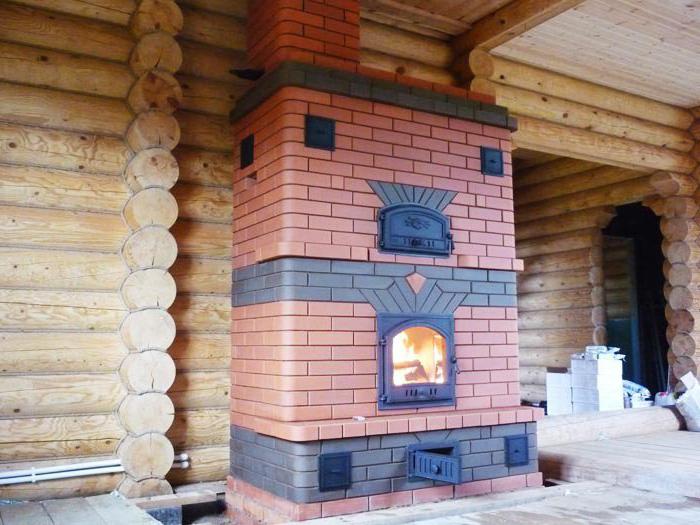

In regions where there is no gas and there are regular interruptions in the supply of electricity (in other words, they constantly turn off the lights), many people heat their homes using a conventional stove. This is the most budgetary option: the construction of the structure does not take much time and does not require huge capital investments. It is built from bricks, clay, sand. For the grill, doors, latches, metal is also needed.
But heating a house with a stove is a rather laborious task. You need to regularly add fuel, rake out ash, monitor the heat. It is also important to organize a dry storage area for fuel. The room in which the stove is installed will be constantly contaminated with soot during the heating season. But its main drawback is that it is not able to evenly warm up the entire building.
Energy efficiency of traditional heating systems
The reduction in energy consumption can be influenced by the modification of the usual, frequently used heating systems. For example, using a thermostatic valve will save up to 20% of energy resources. It is installed on the pipe directly in front of the radiator and allows you to regulate the heat transfer of the heater.
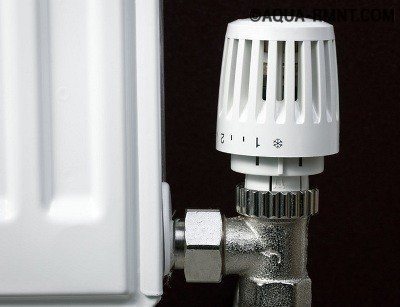

To maintain the set temperature in the room, the operation of the thermostatic valve can be switched to automatic mode by installing additional temperature sensors
Instead of introducing one part, you can completely replace the boiler or furnace with more modern equipment, originally designed to save energy resources.
Modified furnaces and boilers
If your home's heating system is outdated, there is a great way to keep your energy costs down. Along with the device of high-quality thermal insulation, it is worth simply replacing the old equipment with an improved one: a new boiler, oil or gas oven. The efficiency of new systems is 90% or more.
Modern stoves, thanks to a branched system of air ducts, provide heat to every room in the house, and boilers supply heated liquid not only to radiators, but also to warm floors.
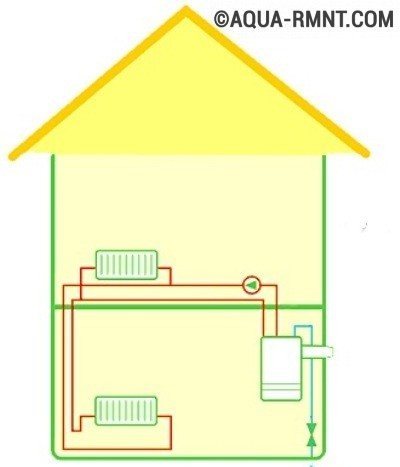

When modernized boilers and furnaces are used in a private house as energy-efficient equipment, the efficiency of the heating system increases to 92-94%
Electric ignition boilers have replaced ignition flame equipment, which, together with more efficient condensers and heat exchangers, reduces fuel consumption. The ventilation system has also changed. The combustion chamber is ventilated not with internal, as before, but with external air, that is, the air in the premises is practically not polluted.
As a result of design changes, boilers and furnaces operating on propane, gas or fuel oil have moved to the category of more economical in terms of fuel consumption, and their environmental class has also increased.
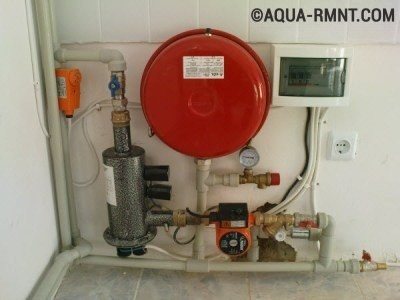

Modern electric boilers do not require a separate room and take up a minimum of free space, so they can be installed in any place convenient for service.
Heating with wood stoves
The large amount of a renewable resource like wood still makes wood-burning stoves popular outside the city. The simple design of heating equipment is not much different from traditional village stoves: they are cast iron or steel devices equipped with a primitive ventilation system. Although modern stoves are more comfortable than previous devices, they are considered the most dangerous - the slightest violation in the design or untimely cleaning can cause a fire.
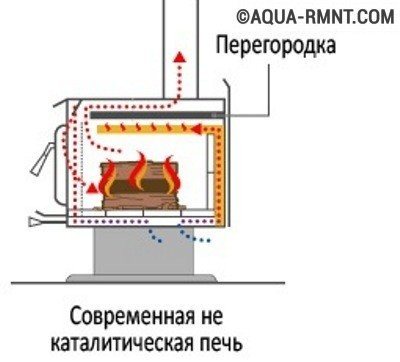

In detached houses that are not connected to the central power supply system, it is possible to use a modern wood-burning stove: the amount of pollution from it is much less than from a conventional stove
Wood-burning stoves have a very low efficiency - as a rule, they heat only those rooms in which they are located, that is, 1-2 rooms. It is possible to increase the efficiency of work by installing a combined gas-and-wood option, which uses not only wood, but also natural gas as a fuel. When using this type of equipment, the heating area is increased due to the branched air duct system.
There is a kind of furnaces that work on the principle of a boiler. They heat the coolant - the water circulating through the pipes. Such equipment is safer, as it is located outside the residential building.
Economical heat pumps
The energy efficiency of heat pumps is based on the features of their operation: they extract heat from water and air. On the same basis, devices are divided into two groups:
- geothermal, operating due to the heat of the earth;
- air, extracting heat from the atmosphere.
Geothermal pumps are equipped with a system of wells reaching a depth of 200 m, or a horizontal pipeline laid below the freezing zone. If necessary, they can heat water, although not to the maximum, but to about + 55 ° C.
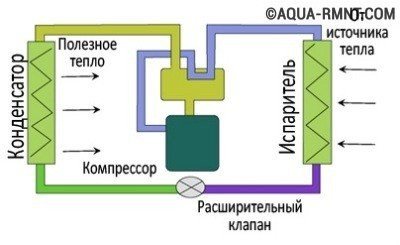

The energy efficiency of geothermal and air heat pumps is quite high: each 1 W of electrical energy used is converted into 3-4 W of thermal energy.
Air pumps are able to generate heat from the air even in 20-degree frost due to the refrigeration principle of operation. The heated air is distributed throughout the building using pipes. One of the advantages of heat pumps is reverse operation: in the heat of summer they can cool rooms.
An available sample of thermal equipment is a "mini-split" system, consisting of indoor and outdoor modules. Air source heat pumps are much cheaper and more affordable for country houses than geothermal installations.
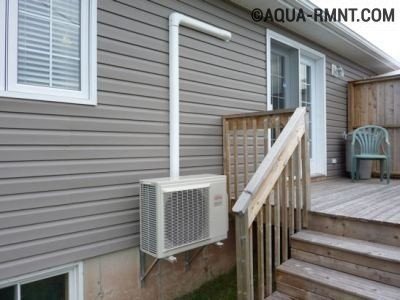

An outdoor unit installed outside draws in cold air and heats (or cools) it. Instead of a duct system inside the building, panels are installed through which heated air enters the premises.
Solid fuel boilers
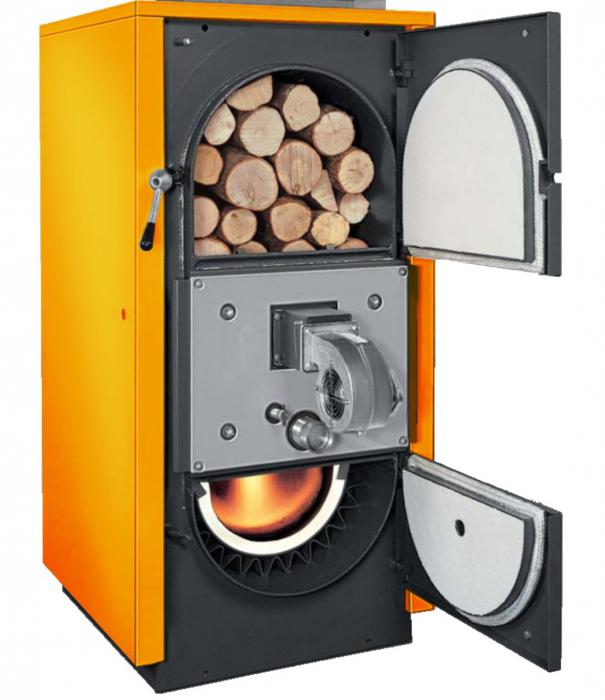

Now people have a great alternative, they do not need to build a stove if they want to give up heating with gas or electricity. Modern solid fuel boilers allow you to heat the house with wood, coal or pallets. They are designed in such a way that the coolant in them heats up to a predetermined temperature, and then enters the radiators intended for heating the house.
There are also versatile options. For example, a gas-firewood heating boiler can fully operate on both solid fuel and gas. Such options are initially equipped with two combustion chambers. Depending on the model chosen, a gas burner can be installed in them, but in some cases it must be purchased independently.
Also on sale you can find combined heating boilers "gas-wood-electricity". In addition to furnaces designed for the use of solid fuel or gas, they are additionally equipped with heating elements. Depending on the situation, the owner of such a unit can choose the mode of operation himself and change the energy source at his own discretion. There are models that change the type of fuel automatically. For example, you can fill up the wood at night, and when it burns out, the boiler will automatically switch to gas heating.
But the cost of universal models is quite high. The average option will cost 200-300 thousand rubles. They, as a rule, are used all year round, because these double-circuit boilers not only heat the premises, but also heat the water.
Solid fuel boilers
Optimal autonomous heating of a country house without gas and electricity is the installation of a solid fuel boiler. The simplest models of units are produced in a non-volatile version, where the combustion air flow is controlled by a mechanical thermostat with a chain drive. But in this case, a number of recommendations must be followed:
- you need to ensure a good natural draft of the chimney;
- when installing the boiler, make sure that the branch pipe for connecting the return line is not higher than the level of the incoming pipe. If necessary, the unit is placed in a small pit;
- the heating system must be gravitational (gravity) and communicate with the atmosphere through an open expansion tank located at the highest point;
- for autonomous heating with a solid fuel heat generator to function reliably and trouble-free, it is necessary to correctly calculate and select all pipe diameters, observe all slopes. At the same time, try not to make too long dead-end branches;
- the boiler must be equipped with a safety group.
Important! In gravitational networks, the coolant moves slowly, a wood-burning heating unit is more susceptible to boiling than in pumping systems. That is why it is so important to comply with all design parameters. It is strongly recommended to use a tank - heat accumulator of sufficient capacity in the circuit.
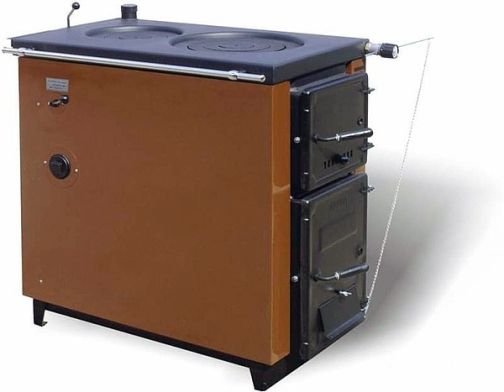

Having considered all types of heating using biomass, it can be noted that the solid fuel boiler will surely take the first place in efficiency, its efficiency reaches 75%, while the best stove will give no more than 60-65%. The option with a boiler and a gravity circuit is applicable even in two-story houses, where the heating will work no worse than a full-fledged system. It will only require more of your time and attention.
Features of the use of solid fuel units
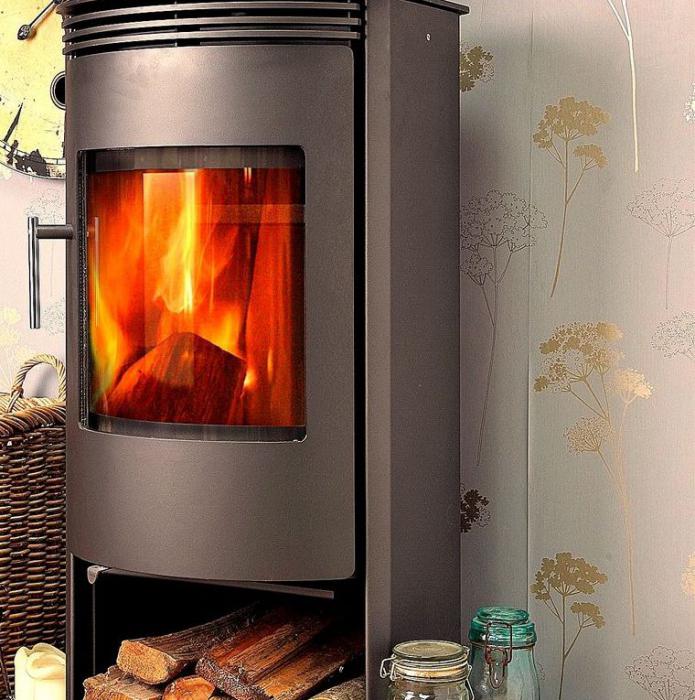

If you decide to make combined heating "gas-wood", then you need to know some of the installation features of the equipment. Of course, its installation must be entrusted to specialists, but you must think over and prepare a place for it in advance. So, despite the relatively small dimensions, each of them will take about 1.5 m2. It is important to take into account that these boilers are heavy. Before installing them in the room intended for them, it is advisable to pour a "pillow" of concrete. Also, a chimney must be made in the boiler room, into which combustion products will be discharged. A special air intake duct is also required.
The space is also taken by the necessary additional equipment. So, simultaneously with the boiler, a circulation pump, an expansion tank is installed. Most models of solid fuel boilers are equipped with several outlets. You can connect to them not only heating radiators and hot water, but also a "warm floor" system, heating of swimming pools, winter gardens and other objects.
Features of pipe connection
Welding
The old-fashioned method for connecting steel pipes is reliable, but morally outdated. It is not safe in a gas boiler room. Welding pipes in hard-to-reach places is terribly inconvenient, and flying sparks spoil the finish. Welding is not recommended for galvanized pipes as it removes the protective layer.
Energobyt Service: More about water treatment
Soldering
Soldering polypropylene pipes It is extremely popular due to its availability: any craftsman can afford an inexpensive soldering iron, the technology seems to be easy to learn. The main disadvantage is that it can be easily violated. For example, if the parts to be connected are overheated, then the pipe inside the fitting turns out to be bent, and its section becomes narrower. This slows down the rate at which the fluid passes through the system. Once the connection is made, the quality of the work cannot be checked.
What it looks like. Two workpieces are put on a double-sided soldering iron - a pipe and a coupling. In a few seconds of heating, the inner surface of the coupling and the outer surface of the pipe melt.The workpieces are removed from the hot nozzles and combined. In half a minute, the connection is ready. The problem is that everything is done by hand, and the quality of the connection literally depends on their hardness. As simple as it looks, so many difficulties lie in wait for the master during the installation. Only many years of experience makes it possible to assemble such a heating system without serious mistakes, but due to the availability of technology, a lot of self-taught beginners are engaged in polypropylene pipes.
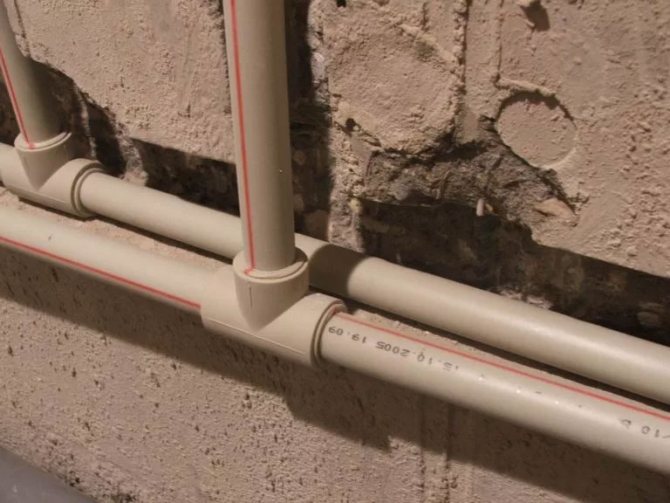

Brazed polypropylene pipes
To connect copper pipes can also be applied soldering, but this is a completely different technology. The pipe and fitting are heated by a gas burner, and the tightness is ensured by the solder - it melts and fills the cavities.
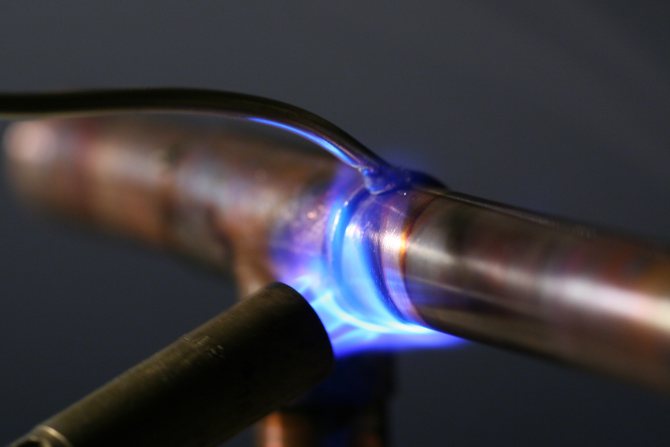

Example of brazing copper pipes
Crimp
Crimp connection created with a compression fitting. The peculiarity is that the connection is collapsible, that is, it is serviced. Compression fittings are used on all types of pipes. The method is fast and quite modern, but it requires experience. The tightness and reliability of the connection largely depends on the condition of the O-rings and rubber gasket, which can be damaged by pipe or pressure. This connection must be checked and the nut tightened every few years.
Crimping
Another "cold" connection, but in comparison with crimping, it is a permanent connection. The fitting is firmly fixed around the pipe with a special tool - a radial press. This is more accurate work than manual soldering: separate pliers are used for each pipe diameter, and the force is controlled by automation. The result is a tight and reliable connection that will last for decades. Pressure testing is used on all types of pipes.
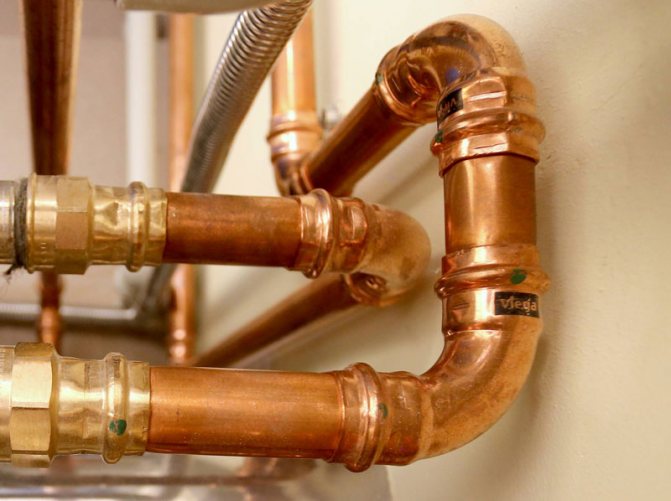

Pipe crimping example
Threaded connection
It is used on steel pipes, especially on galvanized pipes. The main difficulty lies in the threading process, which significantly lengthens the installation process compared to other methods.
Head Denis Hannanov:
From our experience, we recommend our customers to crimp connections. If you follow the installation technology, then the quality of such connections does not raise questions. There have been no leaks in more than five years of operation. In terms of convenience and speed of installation, press fittings are one of the best technologies. Unlike brazing, where pipes are connected in series, pressure testing allows you to first lay pipes, and only then connect them. There are no inconvenient or hard-to-reach places for the press pliers, while it is difficult to work with a bulky soldering iron in any confined space.
Besides the installation method and the skill of the engineers, the choice of materials is extremely important. Their quality depends on the manufacturer. Experience shows that the most reliable pipes and connections to them are produced in Europe, in particular in Germany. According to German standards, only non-separable press connections are suitable for concealed installation.Over time, we began to constantly use press fittings of the German company Viega, we are satisfied with their quality. The Viega Megapress press connection technology was quickly adopted and completely adopted. Other manufacturers of pipes and fittings we work with: Rehau, Oventrop, Uponor. Energobyt Service gives a guarantee for its work. Therefore, we are primarily interested in the trouble-free and durability of the pipeline that we are installing.
Installation of heating radiators using Viega press fittings by Energobyt Service engineers.
Oil-fired boilers
Modern engineering solutions allow you to make heating in the house without gas and firewood. The simplest solution would be to install a liquid fuel unit. Diesel fuel, kerosene or rapeseed oil will be needed to operate and heat the coolant. There are two types of such units: hot water and steam.The latter are considered more preferable: they are easy to install and are compact in size.
The advantages of these boilers, which make it possible to organize heating in a residential building without gas and firewood, include high efficiency. Even large areas can be heated with their help. But they have significant drawbacks. The main one is fire hazard. In addition, oil boilers are quite expensive to operate. The price of diesel fuel is quite high, and a lot of it is needed for the full operation of the boiler. So, in order to generate 1 Gcal in a conventional liquid fuel boiler, more than 100 liters of fuel are needed.
Which fuel is more profitable
Heating boilers run on different types of fuel. And the most common fuel is not always beneficial for the consumer.
For comparison, you can consider several options:
- Heating devices powered by electricity. This is an alternative heating of a private house without gas, but it is more expensive.
- Gas boilers. Main gas is much cheaper than electricity. Balloon will cost several times more.
- Diesel fuel. It is not difficult to organize heating on a diesel engine, but it will not cost cheap. In addition, a strong odor near heating equipment is a big disadvantage. This fuel is used when it is necessary to organize heating of a private house without gas and electricity.
- Coal is 3-4 times cheaper than diesel fuel. Used for stoves, fireplaces and solid fuel boilers.
- Peat briquettes are more expensive than coal, but in many cases it is more convenient to use them.
- Firewood is the most common type of solid fuel and the cheapest, but it is not very convenient to use, as it burns out quickly. Usually they prepare firewood for heating in the country without gas. Pellets are wood pellets, which are mainly used for heating equipment, with an automatic fuel supply function. Pellets have been chosen more and more often lately when it is necessary to solve the problem of how to heat a house without gas and electricity.
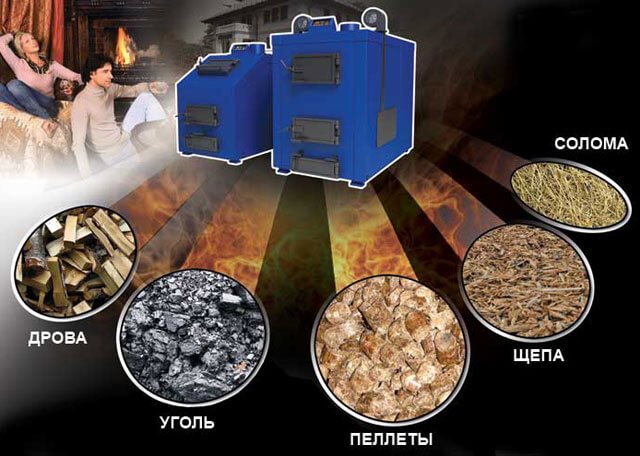

Each type of fuel has its own advantages and disadvantages. More affordable fuel is more often chosen for heating a house or summer cottage.
Heat pump


It is possible to organize heating without gas, firewood, and electricity using new fashionable alternatives. One of the environmentally friendly and safe options is a heat pump. It can extract heat from the bowels of the earth, extract it from air or water. Its advantages undoubtedly include its high efficiency. From each kW of energy spent in the pump drive, 5-6 kW is obtained. But this is one of the most expensive ways to organize heating without gas and firewood, pipes and boilers.
Reviews of people who decided to install this expensive equipment indicate that it is better to mount it in large 2-3-storey cottages. For small houses, it is better to buy a traditional boiler.
Without using gas and electricity
Today, there are several alternative options for heating a room, which do not require electricity or gas supply. Such heating from pipes without batteries will save money. Heating system options can be as follows:
- stoves and fireplaces. They heat the room by using the energy of burning wood or coal. If you decide and choose this option, you will need to build a stove or purchase a ready-made communication, which you just need to install correctly. At the same time, as a result, the family receives an environmentally friendly and economical heating method, and if the stove is equipped with a frying surface, then it will quite cope with cooking;
- an autonomous heating system from a personal source of electricity, which can be obtained in two ways:
- with the help of sunlight. Here you have to spend money on special solar collectors that can convert solar energy into thermal energy and thus work as a heater.Naturally, you will have to invest in the purchase of equipment, but the expenses will be one-time, and the receipt of electricity is constant;
- using the power and energy of the wind. To do this, you will have to build a special apparatus, which consists of a turntable, a generator and a battery. If you can't assemble it yourself, you can purchase a ready-made structure that converts the force of the wind into electricity.
All these methods work effectively without pipes, batteries and boilers, they are ideal for heating a one-story small country house in an area that is far from the gas line.
Video 2. Heating without gas and firewood. New!
Without pipes and boilers
An autonomous heating system is often equipped with a boiler to which pipe-radiator communications are connected, which allow you to heat several rooms at once. However, correctly selected heating without pipes and batteries, which operates from a single heat source, can work just as effectively. Most often these are:
- a brick luggage or metal stove, which is ideal for supplying heat to one room or two adjacent rooms;
- a fireplace that was used in ancient times to heat locks;
- heater of electric type, reflex or oil-based;
- air conditioners, etc.
Remember that for a country house, which is built according to the old five-wall principle, it is quite enough for high-quality heating of one stove, which is located in the middle of the house. Even today, in such structures, heating is carried out without pipes, batteries and boilers.
Heating without fuel
Scientists have already invented a way to heat a room without using any fuel resources. It can be achieved using a device such as a heat pump.
It consists of pipes that are filled with freon, as well as a throttle, compressor and heat exchange chambers. The device works according to the refrigerator scheme and is based on simple physical laws.
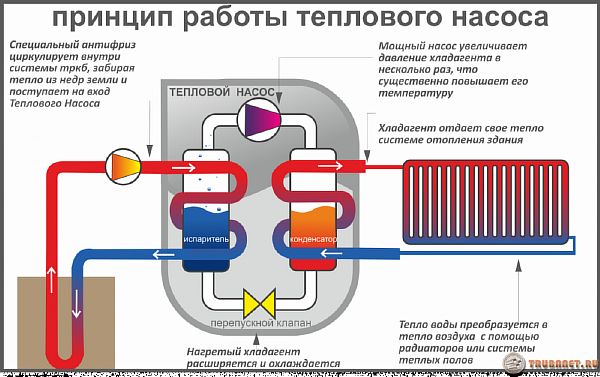

The pipes are located deep underground or in a lake at a decent depth so that the ambient temperature does not rise above 80C, even on the hottest day.
Already at 3 0C, freon boils and rises along them into the compressor, where it is compressed and thus heats up to 80 0C.
The resulting heat is transferred to the heating system, penetrating through the heat exchanger. After that, freon enters the throttle chamber, where its temperature decreases and the pressure is normalized, converting freon into a liquid state.
In this form, it is sent back to the highway underground, repeating the cycle in a circle.
Heat without heating
Even without a heating system, without pipes, batteries and boilers, it is possible to warm up in the room.
I personally treat this method with a grin, but in nature there is such an option, so we will describe it in the article (this is especially true for psychological heating).
There are several methods that can be used together or separately. These include:
- maximum insulation of your home. To preserve the particles of heat that come in after cooking food, breathing residents, etc. it is enough to insulate the walls, add warm floor coverings to the interior, heavy curtains on the windows so that they block the access of cold air and prevent heat from leaving the room, etc. Even if the heating system works as it should, such nuances will save energy resources and not consume more heat than needed;
- warming home wardrobe. Wear a warm sweater and slippers. While watching TV, cover yourself with a warm blanket or use a warm cape, a heating pad in bed and warm drinks (tea, milk);
- psychological heating. We change the design of the room, its color scheme for a warmer one (peach, yellow), add knitted decorative elements and wooden accessories. Use scented candles and photographs of warm countries in the interior.Thus, there is an impact in two directions: on the eyes and touch. So you can deceive the body and make it feel warm.
In any case, you can find an opportunity and a suitable method to warm your home. Heating without pipes and boilers can be an effective solution to this problem, even in severe frosts. Using the above methods, you will be able to warm your home even in the most unusual situations.
Work organization
To install a heat pump, you need to make a circuit. If your house is on rocky soil, then one or more wells are made in it. Their total length is calculated based on the fact that there is about 50 watts of energy for every meter of the hole in the ground. If you plan to install a 10 kW heat pump, then you will need wells with a total depth of about 200 m.
If there is a plot of about 600 m2 near your house, then you can make an earthen contour. In order to make heating without gas and firewood, it is necessary to install special pipelines at a depth of soil freezing. To obtain 10 kW, it is necessary that the circuit be about 500 m long.
The most preferred option is to use the nearest body of water. It must be flowing and large enough in size. It is necessary to install a water circuit with a total length of 333 m. This length is sufficient to produce 10 kW.
Air circuits are used least often. This is due to the fact that the minimum temperature at which such a pump can operate is -20 ° C.
Its principle of operation is the same as that of any refrigeration machine. It consumes electricity and converts it into heat energy. The pump removes heat from the cooled products, and the condenser transfers it to the room. That is, heat is taken from the bowels of the earth.
Infrared Film Panels
Infrared heaters have supporters and opponents. Many see them as the heating of the future - efficient, environmentally friendly, absolutely safe heating devices are installed in any part of the house: on the walls, ceiling and even in the floor. But ease of installation is not the main advantage of film panels.
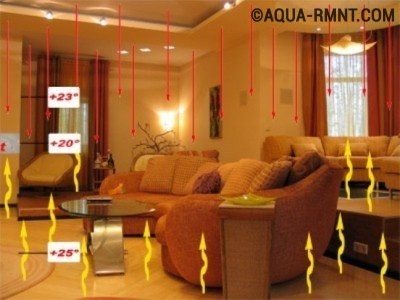

When purchasing an infrared heater, pay attention to characteristics such as the intended installation height. The most common parameters are from 2.1 to 3.2 m
Infrared equipment hit the wide market back in 1967 and immediately became popular due to a completely new principle of operation. The panels heat, like the sun's rays, not the air in the room, but the surrounding objects, as a result, all surfaces in the room begin to radiate heat. The functionality of the appliances, which is comfortable for residents, is complemented by an aesthetic appeal, which interior designers are willing to use.
The heating process evenly distributes heat throughout the room, so there is no sharp difference between the air temperature near the floor and under the ceiling. The absence of temperature extremes saves energy by as much as 60%.
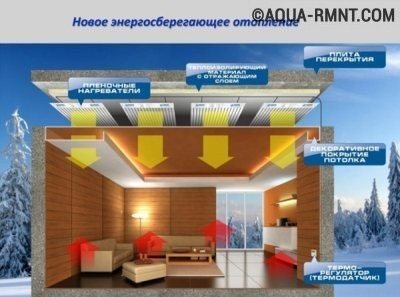

There are two common types of installation of infrared film panels: directly on the ceiling or under a decorative surface that is not an obstacle to I / C beams
An example of infrared equipment is the PLEN system, which can completely replace centralized heating. Manufacturers give 50 years of operation without additional maintenance and 10 years of warranty. The power consumption of the system is no more than 20 W / m² per hour. A thin film in the laminate is attached to the selected place and does not clutter up the room, as heating radiators do. PLEN products are manufactured in Russia, so it is easy to purchase them from dealers anywhere in the country.
Solar panels
It is also possible to organize completely autonomous heating without gas and firewood, pipes and boilers.For these purposes, solar collectors are installed on houses. One of the main advantages is the environmental friendliness of these structures. But they also have significant drawbacks. First of all, it is important that their work directly depends on weather conditions. Also, do not forget that their purchase and installation are quite expensive. Also, special attention is paid to thermal insulation. Its organization significantly increases the cost of connecting such heating.
Without pipes and boilers
An autonomous heating system is often equipped with a boiler to which pipe-radiator communications are connected, which allow you to heat several rooms at once. However, correctly selected heating without pipes and batteries, which operates from a single heat source, can work just as effectively. Most often these are:
- a brick luggage or metal stove, which is ideal for supplying heat to one room or two adjacent rooms;
- a fireplace that was used in ancient times to heat locks;
- heater of electric type, reflex or oil-based;
- air conditioners, etc.
Remember that for a country house, which is built according to the old five-wall principle, it is quite enough for high-quality heating of one stove, which is located in the middle of the house. Even today, in such structures, heating is carried out without pipes, batteries and boilers.
Consumer opinions
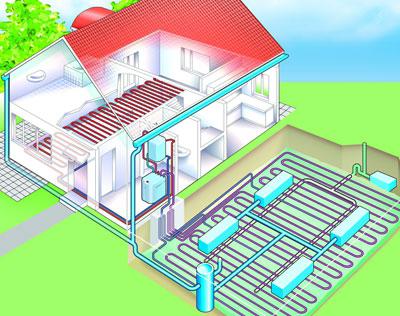

Having become interested in alternative energy sources, many consider them the most optimal option. But, as practice shows, they are not perfect. The cost of installing environmentally friendly heating options is quite high. Because of this, they have a long payback period. If we talk about such a heating source as a heat pump, then electricity is needed for its operation. Therefore, many recommend combining its installation with the purchase of a diesel generator.
For areas where there is no gas and interruptions in light, it is best to purchase solid fuel boilers. For smaller homes, there are relatively inexpensive options. According to ordinary people, they are the best substitute for stove heating.
How not to freeze without heating
There is a situation when the creation of a heating system is simply impossible or it is temporarily disabled, and you need to take care of the insulation of the home.
Globally, this will not solve the problem, but, as a temporary measure, it will keep the accumulated heat in the house:
- close all cracks in window and door openings;
- old windows are additionally covered with plastic wrap;
- insulate walls, floors and an attic with heat-insulating materials;
- close the interior openings with thick curtains.
You should know that any textile helps to retain heat, psychologically a person is affected by warm colors in the interior of the room. And, of course, hot tea and cozy fur slippers will help keep you warm on cold evenings. All these measures should be taken even when the heating is in order in order to use energy resources more economically.

